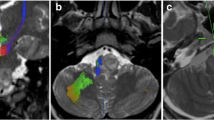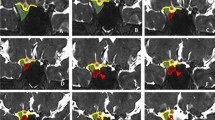Abstract
Cavernous angiomas of the spinal cord exhibit imaging characteristics that may overlap with those of hemorrhagic ependymoma. In the present study, we aimed to identify specific magnetic resonance imaging (MRI) findings that could be used to differentiate cavernous angioma from hemorrhagic ependymoma, and to evaluate serial MRI changes in cases of cavernous angioma. We retrospectively evaluated MR images of spinal cord tumors collected at our hospital from 2007 to 2015. From this cohort of images, 11 pathologically confirmed cavernous angiomas and 14 pathologically confirmed hemorrhagic ependymomas were compared with respect to the size of the tumor, longitudinal location, axial location, enhancement pattern, syrinx, edema, tumor margin, signal intensity of T2WI, signal intensity of T1WI, and longitudinal spreading of the hemorrhage. Serial MR images of seven spinal cavernous angiomas were reviewed. Small size, eccentric axial location, minimal enhancement, and absence of edema were more frequently observed on images of cavernous angioma compared to those of hemorrhagic ependymoma (p < 0.01). Serial MRI changes in cases of cavernous angioma included increased longitudinal spreading of the hemorrhage (6/7, 86 %) and emergence of high signal intensity on T1WI (1/7, 14 %). Small size, eccentric axial location, minimal enhancement, and absence of edema are significant MRI findings that may be used to distinguish Type I and Type II spinal cavernous angiomas from hemorrhagic ependymomas. Furthermore, longitudinal spreading of the hemorrhage may be observed on follow-up MRIs of cavernous angiomas.



Similar content being viewed by others
References
Lee ST, Choi KW, Yeo HT, Kim JW, Ki CS, Cho YD (2008) Identification of an Arg35X mutation in the PDCD10 gene in a patient with cerebral and multiple spinal cavernous malformations. J Neurol Sci 267:177–181. doi:10.1016/j.jns.2007.10.018
Deutsch H, Jallo GI, Faktorovich A, Epstein F (2000) Spinal intramedullary cavernoma: clinical presentation and surgical outcome. J Neurosurg 93:65–70
Spetzger U, Gilsbach JM, Bertalanffy H (1995) Cavernous angiomas of the spinal cord clinical presentation, surgical strategy, and postoperative results. Acta Neurochir (Wien) 134:200–206
Rigamonti D, Drayer BP, Johnson PC, Hadley MN, Zabramski J, Spetzler RF (1987) The MRI appearance of cavernous malformations (angiomas). J Neurosurg 67:518–524. doi:10.3171/jns.1987.67.4.0518
Fine MJ, Kricheff, II, Freed D, Epstein FJ (1995) Spinal cord ependymomas: MR imaging features. Radiology 197:655–658. doi:10.1148/radiology.197.3.7480734
Kharkar S, Shuck J, Conway J, Rigamonti D (2007) The natural history of conservatively managed symptomatic intramedullary spinal cord cavernomas. Neurosurgery 60:865–872. doi:10.1227/01.NEU.0000255437.36742.15 (discussion 865–872)
Epstein FJ, Farmer JP, Freed D (1993) Adult intramedullary spinal cord ependymomas: the result of surgery in 38 patients. J Neurosurg 79:204–209. doi:10.3171/jns.1993.79.2.0204
Hoshimaru M, Koyama T, Hashimoto N, Kikuchi H (1999) Results of microsurgical treatment for intramedullary spinal cord ependymomas: analysis of 36 cases. Neurosurgery 44:264–269
Zabramski JM, Wascher, Spetzler RF, Johnson B, Golfinos J, Drayer BP, Brown B, Rigamonti D, Brown G (1994) The natural history of familial cavernous malformations: results of an ongoing study. J Neurosurg 80:422–432. doi:10.3171/jns.1994.80.3.0422
Zimmerman RA, Bilaniuk LT (1988) Imaging of tumors of the spinal canal and cord. Radiol Clin North Am 26:965–1007
Houtteville JP (1997) Brain cavernoma: a dynamic lesion. Surg Neurol 48:610–614
Vishteh AG, Sankhla S, Anson JA, Zabramski JM, Spetzler RF (1997) Surgical resection of intramedullary spinal cord cavernous malformations: delayed complications, long-term outcomes, and association with cryptic venous malformations. Neurosurgery 41:1094–1100 (discussion 1100–1091)
Ardeshiri A, Ozkan N, Chen B, Stein KP, Miller D, Hutter BO, Sandalcioglu IE, Sure U (2015) A retrospective and consecutive analysis of the epidemiology and management of spinal cavernomas over the last 20 years in a single center. Neurosurg Rev. doi:10.1007/s10143-015-0674-7
Stone JL, Lichtor T, Ruge JR (1995) Cavernous angioma of the upper cervical spinal cord. A case report. Spine (Phila Pa 1976) 20:1205–1207
Balousek P, Ammirati M (1996) Exophytic cavernous malformation of the cervical spinal cord. Acta Neurochir (Wien) 138:890–892
Kahan H, Sklar EM, Post MJ, Bruce JH (1996) MR characteristics of histopathologic subtypes of spinal ependymoma. Am J Neuroradiol 17:143–150
Leech RW, Pitha JV, Brumback RA (1991) Spontaneous haematomyelia: a necropsy study. J Neurol Neurosurg Psychiatry 54:172–174
Milhorat TH, Adler DE, Heger IM, Miller JI, Hollenberg-Sher JR (1991) Histopathology of experimental hematomyelia. J Neurosurg 75:911–915. doi:10.3171/jns.1991.75.6.0911
Ginat DT, Meyers SP (2012) Intracranial lesions with high signal intensity on T1-weighted MR images: differential diagnosis. Radiographics 32:499–516. doi:10.1148/rg.322105761
Kang BK, Na DG, Ryoo JW, Byun HS, Roh HG, Pyeun YS (2001) Diffusion-weighted MR imaging of intracerebral hemorrhage. Korean J Radiol 2:183–191. doi:10.3348/kjr.2001.2.4.183
McCormick PC, Michelsen WJ, Post KD, Carmel PW, Stein BM (1988) Cavernous malformations of the spinal cord. Neurosurgery 23:459–463
Funding
This study was supported by a new faculty research seed money grant of Yonsei University College of Medicine for 2016(2016-32-0023).
Author information
Authors and Affiliations
Corresponding author
Ethics declarations
Conflict of interest
We declare that we have no conflict of interest.
Rights and permissions
About this article
Cite this article
Jeon, I., Jung, W.S., Suh, S.H. et al. MR imaging features that distinguish spinal cavernous angioma from hemorrhagic ependymoma and serial MRI changes in cavernous angioma. J Neurooncol 130, 229–236 (2016). https://doi.org/10.1007/s11060-016-2239-1
Received:
Accepted:
Published:
Issue Date:
DOI: https://doi.org/10.1007/s11060-016-2239-1




